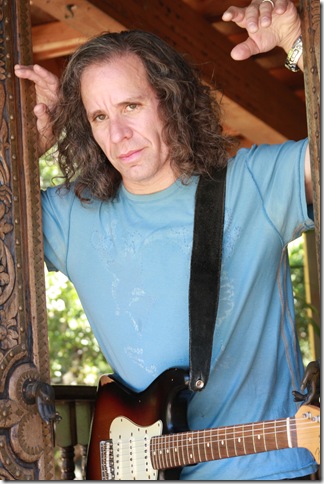Guitarist and vocalist Chris Duarte hails from Texas, the home state of guitar heroes like Freddie King, Albert Collins, Johnny Winter, Jimmie Vaughan, and Billy Gibbons of ZZ Top. Yet that’s where the comparisons to those blues-based icons blur.
Duarte’s influences extend further, encompassing both jazz/fusion and metal. Which likens his incendiary playing style more toward late Dallas blues comet Stevie Ray Vaughan; Austin instrumental specialist Eric Johnson; and Ty Tabor of the underrated veteran Houston rock trio King’s X.
A 49-year-old Austin resident and San Antonio native, Duarte also showed leanings from reggae and funk to alt-rock and punk Friday night at the Bamboo Room in Lake Worth. Playing with bassist Dustin Sargent and drummer Dave Anthony, he augmented material from his 1994 debut Texas Sugar Strat Magik through his latest release, the 2011 disc Blues In the Afterburner, with surprising cover tunes that illustrated his diversity and open mind.
With a near-capacity crowd in attendance, the affable Duarte entered the room on time for his 9 p.m. show, only to talk to fans for 10 minutes before taking the stage. His opener ― the Freddie King instrumental blues shuffle Hide Away ― was the only predictable cover of the evening, yet its Peter Gunn-themed midsection and Duarte’s long, frenetic closing solo set precedents.
Ridin’, from Duarte’s 2010 release Infinite Energy, took things further outside. A frantic rocker with punk undertones, the piece featured Duarte’s barking vocals, a half-timed funk bridge and a staggered, fusion-approved twist back into the main theme ― all aided by the guitarist’s infectious, animated energy and physical solos on the first of two Fender Stratocaster guitars he played.
Two funk efforts from Texas Sugar Strat Magik, Scrawl and Big-Legged Woman, showcased Duarte’s strengths as a chordal rhythm player as well as a manic soloist, even if his physicality (he even leaned on the body of his guitar with his right forearm occasionally to change its tone) and whammy bar usage often caused both guitars to go out of tune.
“Thank you!” Duarte hollered into the microphone, a recurring theme during his frequent tune-ups. “We’re going to do a song off of the new album now. This is called ‘Make Me Feel So Right.’”
Although energetic, that shuffle didn’t quite measure up to the tunes that surrounded it, pointing out the difference between Duarte and the late Vaughan (the guitarist he’s most often compared to). An expert shuffle player, SRV was a bluesman who could rock, while Duarte is a rocker at heart who plays the blues.
Yet as if to answer, Duarte’s slow, burning Bottle Blues pointed out his non-shuffle roots music strengths. His hummingbird rhythm playing and better-than-usual vocal delivery led to solos where he used the entire guitar neck with his fretting hand, a Vaughan trademark. The dynamics of veteran Duarte bassist Sargent and relative drumming newcomer Anthony allowed the guitarist to whisper, scream, and everything in between.
Duarte used a spacey, delay-pedal-enhanced intro to surprise with one of Bob Dylan’s lesser-mined gems, One More Cup, on which Anthony created reggae underpinnings with his rimshots. The anthemic Sundown Blues from the Infinite Energy CD followed, creating another late-set highlight. With its slow, bluesy cadence; metallic and fusion elements and a Tabor-ish solo, the track bore a resemblance to the work of Jimi Hendrix circa his stellar, latter-era Band of Gypsys.
Like set one, set two worked best when Duarte rocked. His screaming, Johnny B. Goode-style intro energized the leadoff The Best I Can Do in ways that didn’t apply to its subsequent fellow track from the 2008 CD Vantage Point, the shuffling Satisfy.
“Here’s something else that always works,” Duarte said afterward, “another song in the key of E.” His accents with Sargent and Anthony then made the burner from his 1997 album Tailspin Headwhack work. The funky, surf music-influenced instrumental Drivin’ also clicked through Duarte’s use of feedback, achieved by leaning the face of his guitar into his amplifier, and Anthony’s muscular fills near its coda.
The guitarist closed the set with an unaccompanied solo on which played the body of his guitar over pedal loops as he created them by hand, resulting in a white noise-cacophony. Yet even that creative, unorthodox display paled in comparison to Duarte’s choice for a second-set cover tune.
Screenwriter’s Blues, from the debut 1994 Ruby Vroom CD by New York City quartet Soul Coughing, proved absurdist musical theater. Duarte accurately mimicked the poetic rap delivery of the ’90s group’s vocalist, M. Doughty, as he also created a hip-hop instrumental undercurrent with Sargent and Anthony (all of whom took creative liberties with a crazed midsection to extend the hypnotic crowd-pleaser to near 10 minutes).
Duarte has fans from instrumental rocker Joe Satriani to classic rocker Ted Nugent and jazz and blues whiz Scott Henderson. Yet they’re all guitarists, likely the primary block of his fan base. If he ever wants to break into the wider realm of Hendrix and Vaughan ― each likewise a virtuoso guitarist who was a passable singer ― Duarte may need to learn more subtlety. He has the technique and the tone in spades, and only needs to shed his shred tendencies to realize that less can occasionally be tastefully more. Bandmates who sing backup would also help address the fact that his own vocals can’t match his playing.
Still, it’s hard not to get caught up in the ageless Duarte’s exuberance. On this night, he talked to anyone who approached him like they were old friends, and looked like he wanted to continue even after playing two sets totaling two-and-a-half hours. It’s simply his nature to want to play more, not less.
